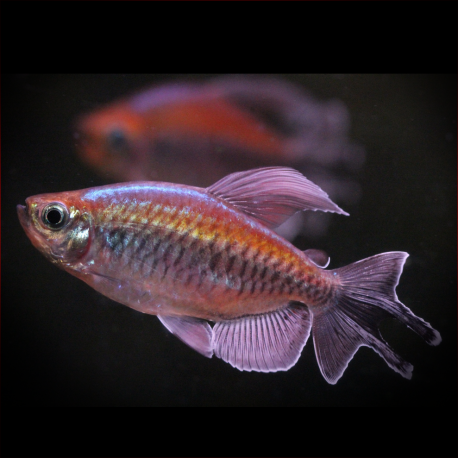More info
Datasheet
| Minimum Tank Size | 108 litres / 28.53 US gallons |
| Maximum Size | 8.0cm / 3.15inches |
| Temperature | 23°C / 73.40°F - 28°C / 82.40°F |
| Hardness | 3-18ºdH |
| pH | 6.0-7.5 |
General Description
The Congo Tetra (Phenacogrammus Interruptus) is a species known for its sensitivity to water quality, requiring a high standard to maintain the development of the males' fins and vibrant coloration. Initially appearing drab, these tetras transform into stunningly colorful fish with the right care and environment, especially when lit from the front and above.
Aquarium Setup
For optimal care, Congo Tetras thrive in a well-planted setup with ample swimming space. Ideally, an African biotope tank with driftwood branches, floating vegetation, and anubias suits them best. The water conditions should be slightly acidic to neutral, soft, and well-circulated, offering a habitat that mimics their natural environment.
Behaviour
Known for their peaceful nature, Congo Tetras can startle shy species due to their active swimming behavior and relatively large adult size. They are recommended for community tanks, coexisting well with tetras, rainbowfish, Corydoras, Loricariids, and peaceful cichlids like Pelvicachromis sp. or Cleithracara. To avoid damaging their spectacular fins, it is advised not to house them with fin-nipping or boisterous tankmates. Keeping a mixed-sex shoal enhances their natural behavior.
Feeding and Diet
Congo Tetras are omnivores, feeding on small worms, insects, crustaceans, algae, and zooplankton in their natural habitat. While they are not picky eaters, a diet rich in live and frozen foods brings out their best coloration. Ensuring a good proportion of live and frozen food in their diet is recommended for their overall health and vibrancy.
Reproduction & Dimorphism
Reproducing Congo Tetras is challenging but feasible. They are egg-scatterers, with successful breeding requiring conditioning with live and frozen foods. Males and females with the best colors and condition are selected and placed in a separate tank for spawning. The water parameters should be below neutral pH and soft, with subdued lighting and vegetation to induce spawning. The males chase the females during spawning, and the female can lay up to 300 large eggs. The male Congo Tetras are larger, more colorful, and develop extended filaments in their fins.
Habitat and Distribution
In the wild, Congo Tetras are endemic to parts of the River Congo drainage in the Democratic Republic of Congo. Although wild populations are limited to this region, most Congo Tetras in the trade are commercially bred in the Far East and Eastern Europe. Their natural habitat includes freshwater rivers and tributaries with dense vegetation, influencing their tank preferences and setup requirements.

